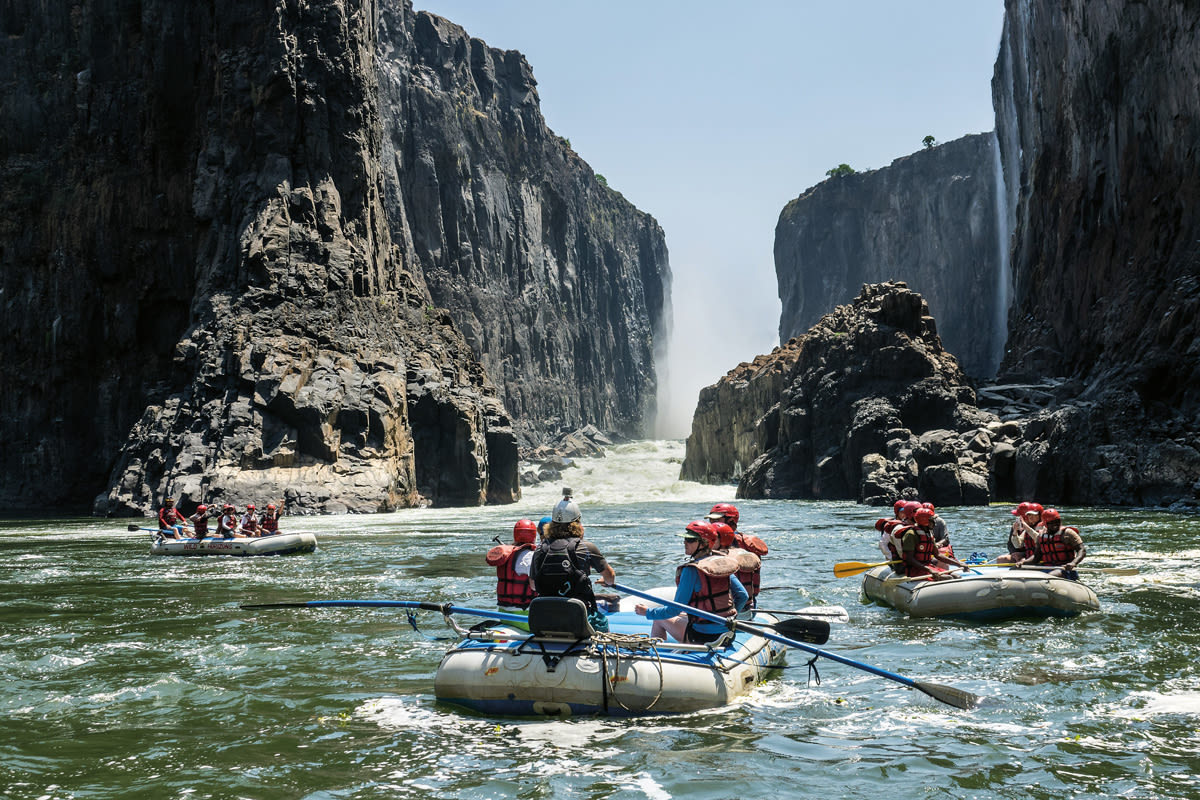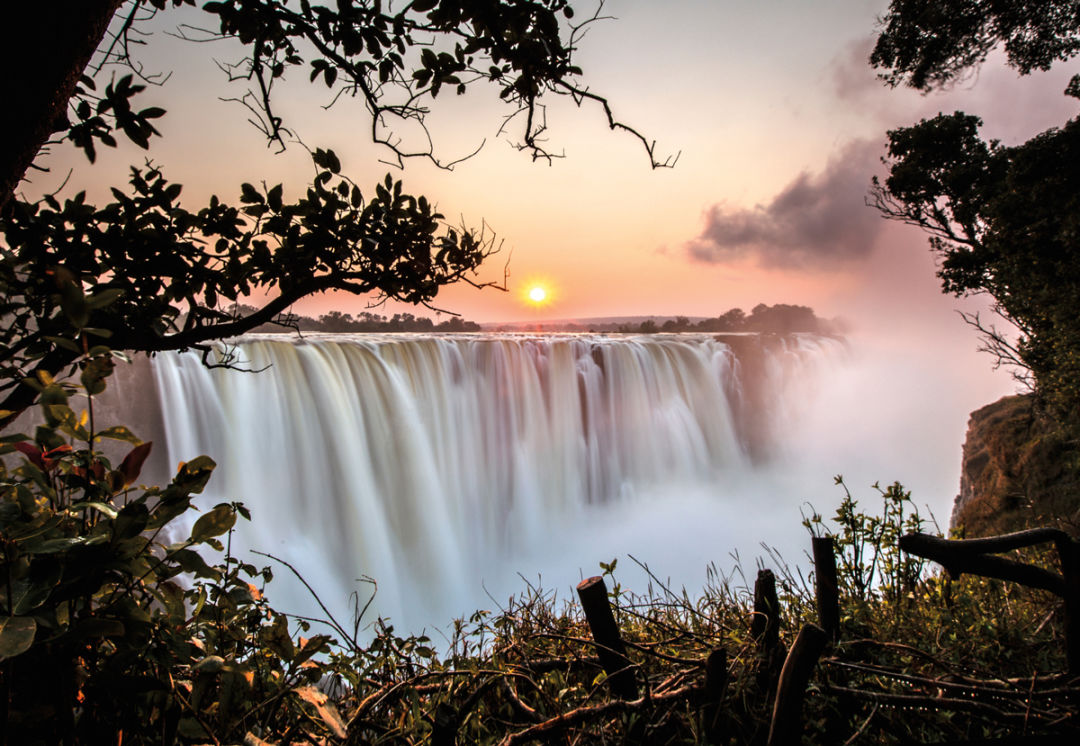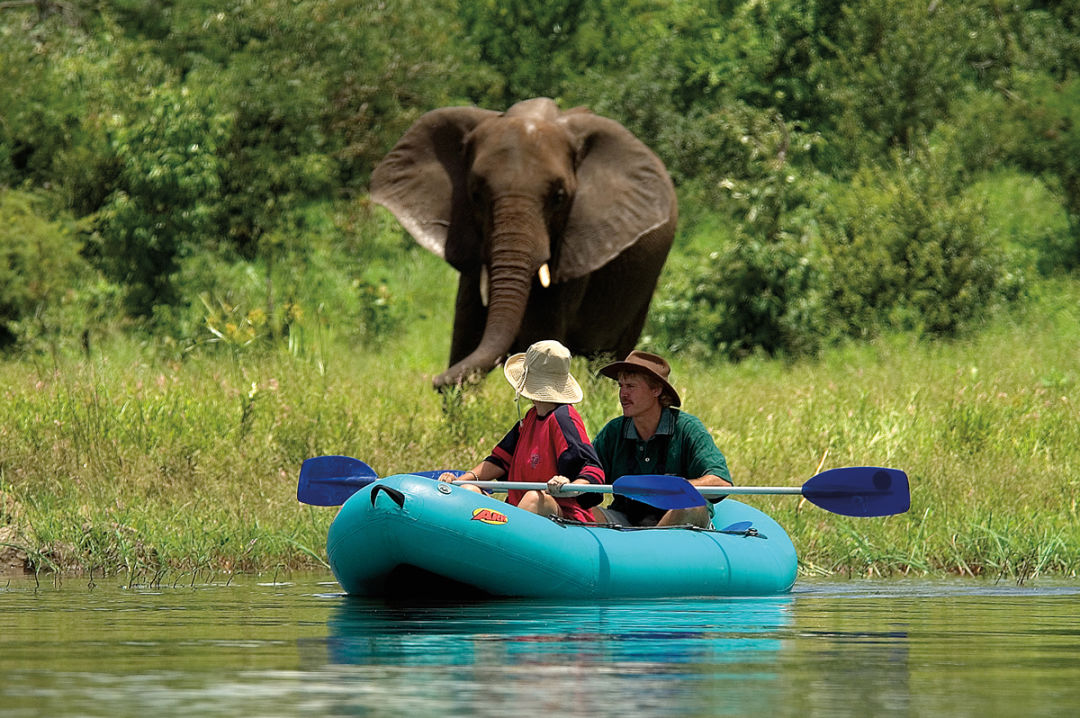
Raft Africa's Middle Zambezi While You Still Can
I’m standing on a patch of beach on Zimbabwe’s Upper Zambezi River, sipping a gin and tonic as the setting sun turns the sky nasturtium orange. Downstream, a pod of hippos erupts into a cacophony of grunts. Earlier, we’d startled one of the animals while paddling inflatable tandem kayaks, giving our group of 14 Americans new respect for our rafting guide’s command to “dig in!”
Before I left home, I was frequently asked why I was flying to the other side of the planet to raft a river. As a kid on family whitewater trips, I’d listen rapt as guides spun narratives about the fabled Zambezi, and it sparked in me a desire to run the world’s wildest rivers. Tall tales aside, the “Slambezi’s” high volume and massive hydraulics have made it the holy grail for skilled kayakers and rafting enthusiasts.
At the time of my visit last fall, the unemployment rate in Zimbabwe was 95 percent, but it’s still a safe destination for travelers. Tourism is vital to the economy; the country is also a world leader in wildlife management and increasingly attracts attention for the quality of its safari lodges and guides.
More controversial is the Batoka Gorge Hydroelectric Power Station, an estimated $4.5 billion project that will provide electricity to parts of Zimbabwe and Zambia. Construction of a dam 34 miles downstream from Victoria Falls is imminent, and completion is slated for 2025. It will have a dire impact upon the region’s environment, as well as the rafting industry and related tourism.
The dam a specter in the back of my mind, I signed up for the 12-day Zambezi Explorer adventure offered by Truckee, California–based outfitter Bio Bio Expeditions (BBX). The itinerary includes stays at a trio of luxury safari lodges, game drives, bungee-jumping off of the Victoria Falls Bridge, a day trip to Botswana’s Chobe National Park (home to one of the world’s largest elephant populations), two days of paddling inflatable kayaks on the Upper Zambezi, and four days of rafting a section of the Middle Zambezi’s remote Batoka Gorge.

Victoria Falls
While it may seem counterintuitive to raft an African river with a North American company, BBX has run commercial trips on the Zambezi for nearly 30 years; its African partner, Zambia-based adventure tour operator Wild Horizons, employs local Tonga people. BBX also emphasizes cultural and philanthropic elements on its trips.
Wild Horizons and BBX are among an elite few companies granted access to Batoka Gorge, which was formed more than 180 million years ago. The 20-mile stretch we raft boasts some 30 Class IV and V rapids, with names like Commercial Suicide, Devil’s Toilet Bowl, and Terminator.
Those rapids live up to their nerve-racking monikers. A rogue wave that flips our six-person raft in a section called the Narrows is fast, furious, and fun; a later capsize leaves us clinging desperately to our boat as we head down another rapid, our guide screaming, “Don’t let go!” Though waterlogged and shaken, by the time our safety kayakers arrive to right us, we’ve gathered our collective wits enough to prioritize the rescue of the overturned beer cooler strapped to our raft.
In between rapids, we escape the equatorial sun by jumping in the water and bobbing alongside our rafts. At night, we feast on grilled ostrich and warthog, and our head guide, Moses “Hippo” Ngoma, teaches us nursery rhymes from Zimbabwe and his native Mali around the fire.
On our final afternoon, we pitch our tents on a beach with a Jurassic-looking rock garden and set up a makeshift volleyball net and a bar constructed of paddles and a tent fly. At sunset, we hike a short distance to an overlook of Lower Moemba Falls and toast one another with South African sparkling wine.
Forty-something years is a long time to fulfill a dream, but my Zambezi adventure has given me much more than the rafting trip of a lifetime. I’ve gained a profound respect for the literal and figurative power of a river that is the lifeblood of southern Africa—a legacy that even a dam can’t take away.
Zambezi Explorer trips (from $5,800) run in September and October, at the end of Zimbabwe’s dry season. bbxrafting.com

Wildlife viewing on the Zambezi
Close Encounters
Our trip ended with two nights at the Elephant Camp, an intimate, 16-suite luxury lodge and wildlife sanctuary outside of Victoria Falls. Wild Horizons operates the camp, as well as the adjacent Victoria Falls Wildlife Trust, a world-renowned rehabilitation center, veterinary lab, and clinic (Colorado State University is a research partner).
Guests can meet and feed the elephants and learn more about the sanctuary, but a star attraction is, unexpectedly, 8-year-old Sylvester the cheetah.
Sylvester was orphaned at two days of age and imprinted on his human caretakers. Unable to be released into the wild, he was taken in by the wildlife trust and now helps educate local schoolchildren, villagers, and guests about conservation. Interact with him at daily meet-and-greets, but for a once-in-a-lifetime experience, join him on a 90-minute supervised sunrise or sunset walk in the open bush.














































